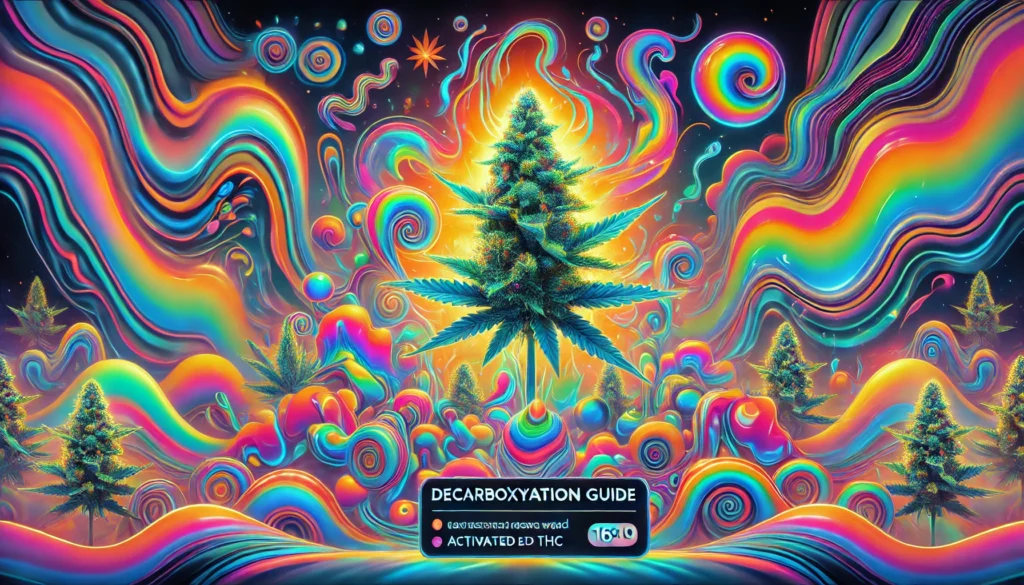If you’re diving into the world of homemade cannabis edibles, understanding decarboxylation is essential. This process transforms raw cannabis into a psychoactive powerhouse, unlocking its full potential. But what exactly is decarboxylation, and how can you achieve the perfect easy decarb weed results at home? Let’s break it down step by step.
When preparing cannabis for edibles or concentrates, one of the most important processes is decarboxylation. But what exactly is decarboxylation, and how can you make sure your weed is decarboxylated correctly to maximize its effects? In this guide, we’ll take a deep dive into everything you need to know about decarboxylating weed-from temperatures and times to methods, tips, and common mistakes to avoid.
What is Decarboxylation?
Decarboxylation refers to the process of heating cannabis to activate its psychoactive compounds. When cannabis is raw, it contains THCA (tetrahydrocannabinolic acid) and CBDA (cannabidiolic acid). Through decarboxylation, these compounds are converted into THC and CBD, the active forms that have the desired effects on the body and mind.
This process is crucial when making cannabutter, cannabis tinctures, or any edible products, as raw cannabis will not provide the same effects as decarbed cannabis.
How does Decarboxylation work?
Decarboxylation works by applying heat to cannabis, which causes the loss of a carbon dioxide molecule from THCA and CBDA. This transforms them into THC and CBD. Without decarboxylation, you wouldn’t experience the full psychoactive effects of cannabis, making it an essential step for anyone looking to make edibles or concentrates.
For example, when you heat your weed in an oven, it triggers this chemical reaction that converts THCA into THC, which is what gives you that euphoric high.
Why Is Decarboxylation Necessary for Edibles?
For those making cannabis-infused edibles, decarboxylation is crucial. Since the stomach doesn’t absorb THCA in its raw form, heating cannabis before adding it to your recipes ensures the conversion of THCA into THC, which your body can then metabolize effectively. Without this step, your edibles will lack potency and fail to deliver the desired effects.
At What Temperature Does Decarboxylation Occur?
The decarboxylation process requires careful attention to temperature.
Decarboxylation Temperature Chart
- THC Activation: The ideal decarboxylation temperature for THC is between 105°C and 115°C (220°F to 240°F).
- CBD Activation: For CBD, the ideal temperature is around 110°C (230°F).
It’s important to use a temperature within this range to activate the cannabis without burning it. Temperatures higher than 120°C (248°F) can degrade the cannabinoids and terpenes, which can reduce potency and flavor.
What Happens If You Decarboxylate Too Long?
Overheating or decarging cannabis for too long can lead to a loss of terpenes and cannabinoids. At higher temperatures, THC can degrade into CBN, which may cause sedative effects rather than the euphoric experience you’re after.
So how do you find the right balance? Generally, decarburizing weed in the oven for about 30-45 minutes at 105°C (220°F) should do the trick.
Should Weed Be Ground Before or After Decarbing?
You may be wondering whether to grind your cannabis before or after decarboxylation. While you can decarb either way, it’s generally better to grind weed before decarbing. Grinding increases the surface area, allowing the heat to penetrate more evenly, ensuring a more consistent decarb process.
However, if you prefer to decarb in a mason jar or other closed containers, grinding before decarbing can make the process cleaner and easier to manage.
How to Decarb Weed in an Oven
The oven is one of the easiest and most popular methods for decarbing cannabis. Here’s how you can do it.
Materials
- Cannabis buds (about 10-14g)
- Baking sheet
- Parchment paper
- Oven
- Grinder (optional)
Steps:
- Preheat your oven to 105°C (220°F).
- Break your cannabis buds into smaller pieces and spread them evenly on a parchment paper-lined baking sheet.
- Place the sheet in the oven and bake for 30 to 45 minutes, stirring halfway through for an even decarb process.
- Allow the decarbed cannabis to cool before using it in cannabutter or other recipes.
Can You Decarb Weed in a Microwave?
Some users wonder if they can decarb weed in a microwave. While this method might work in a pinch, it’s not ideal for an even decarb process. Microwaves tend to have hot spots, which could lead to uneven activation of cannabinoids. Therefore, using an oven or a more controlled method like sous vide or a decarboxylation machine is recommended for the best results.
The Different Methods of Decarbing Cannabis
Aside from using an oven, there are other methods to decarb weed effectively.
1. Oven Decarboxylation
The most common and straightforward method.
2. Closed-Loop Decarboxylation
This method uses a closed-loop system, often seen in high-end decarb machines, to maintain precise temperature control and ensure maximum efficiency.
3. Vacuum Decarboxylation
Utilizing a vacuum chamber, this method allows for decarbing cannabis at lower temperatures to preserve terpenes and cannabinoids better.
4. Fluidized Bed Decarboxylation
A more industrial technique, this method uses a fluidized bed to heat cannabis evenly and efficiently while keeping the environment controlled.
5. Decarboxylation Machines
These machines are specifically designed for decarboxylation, ensuring precise temperature control. Popular options include the Decarb by Ardent or Levo.
6. Microwave-Assisted Decarboxylation
Using microwave radiation, this method provides quick decarboxylation, but it’s less consistent compared to other methods.
7. Sous Vide Decarboxylation
For a slower, more controlled method, sous vide offers precise heat regulation for an even decarb.
Quick Tips for Achieving the Perfect Results from Decarbing Cannabis
- Don’t rush: Take your time to decarb properly. Rushing the process can result in weak, ineffective cannabis.
- Watch your temperature: Use a decarboxylation calculator to help you determine the best temperature and time based on your strain and goals.
- Decarb in small batches: This ensures even decarboxylation and prevents wastage.
- Keep track of decarb time: Generally, cannabis takes between 30-45 minutes in the oven, but this varies depending on your method and batch size.
How to Store Your Decarbed Cannabis Properly
Once your cannabis is decarbed, it’s essential to store it properly to maintain its potency. Use an airtight container, such as a glass jar, and store it in a cool, dry place away from sunlight to prevent degradation.
Unlocking the Power of Cannabinoids with Decarboxylation
By mastering decarboxylation , you unlock the true potential of your cannabis. Whether you’re making edibles, topicals, or concentrates, proper decarbing ensures maximum efficacy.
Other Ways to Decarboxylate Your Weed
Decarb Using a Cooking Pot (Sous Vide)
This method involves sealing cannabis in a vacuum-sealed bag and submerging it in water heated to 220°F (105°C). It’s precise and avoids burning.
Equipment:
- Sous vide machine
- Vacuum sealer
- Heat-safe bags
Instructions:
- Seal cannabis in a bag.
- Set sous vide to 220°F (105°C).
- Submerge for 1-2 hours.
Decarb Using an Herb Cooker
Specialized devices like herb cookers simplify the process. Just load your cannabis, set the timer, and let the machine do the work.
Decarboxylation FAQ
What is the best decarb method?
The oven method is often the easiest and most reliable, but decarboxylation machines provide a more consistent and efficient experience for those willing to invest in specialized equipment.
What are the different ways to decarb weed?
Besides the oven, you can use vacuum decarboxylation, sous vide, closed-loop systems, or decarboxylation machines to achieve the perfect decarb.
What temps are best to decarb weed?
105°C to 115°C (220°F to 240°F) is the ideal range for decarbing weed.
How long does it take to decarb 1 gram?
Generally, it takes around 30 minutes at 105°C to decarb a gram of weed.
What is the fastest decarboxylation method?
The microwave method may decarb weed quickly but is less reliable than other methods like the oven or decarboxylation machines.
How do you properly decarb?
Ensure you maintain the proper temperature, time, and method for consistent results. For the oven method, aim for 30-45 minutes at 105°C (220°F).
Do you grind before or after decarboxylation?
It’s generally better to grind before decarbing for even heat distribution.
Can I decarb weed with aluminum foil?
Yes, you can use aluminum foil to wrap the weed when decarbing, but it’s better to use parchment paper for even heating.
Can weed decarb on its own?
Raw cannabis will naturally decarb over time, but the process is slow and ineffective compared to using heat.
Conclusion
Decarboxylation is an essential process for unlocking the full potential of cannabis, especially for making potent edibles and concentrates. By following the right temperature and time guidelines and selecting a decarb method that works best for you, you can ensure that your cannabis provides the desired effects. Whether you prefer using an oven, decarboxylation machine, or another method, the key is consistency and control.
Ready to start decarbing your cannabis? Share your experience with us in the comments below, or reach out for more tips on creating your own edibles!

